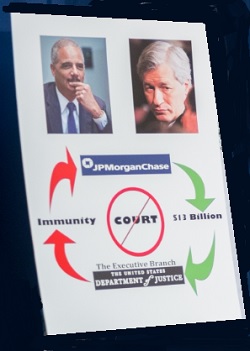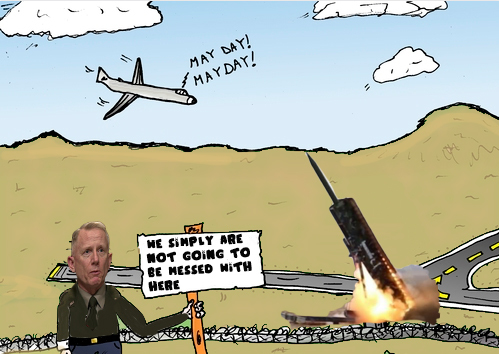Cantaloupe is way nastier. Honeydew smoothies are way way more popular. Cantaloupe is probably better by itself when it's ripe.
voight
You're fucked in the head
Notwithstanding this unprecedented crime wave at JPMorgan Chase, and the ability of Jamie Dimon to not only remain at the helm of the biggest bank in the U.S. ...
... but to become a billionaire from the stock options lavished on him by his Board, federal regulators again proved themselves to be the lapdogs that millions of Americans suspect them to be when they allowed JPMorgan Chase to get $200 billion bigger last year.
George Washington University Law Professor, Art Wilmarth, author of Taming the Megabanks: Why We Need a New Glass-Steagall Act, explained during the Better Markets conferencein September of last year exactly what transpired in the spring of 2023 when regulators handed JPMorgan Chase the collapsed bank, First Republic:
“…When First Republic failed, regulators did not invoke the systemic risk exception. That was a clear and rather shocking error in my opinion. They accepted JPMorgan’s bid to buy most of the assets and assume all of the deposits of First Republic.
“By the way, JPMorgan recorded a profit of almost $3 billion on that transaction. The Deposit Insurance Fund has recognized a loss of at least $13 billion and it may be larger on that transaction. That’s a hard result to justify and I don’t think the FDIC has attempted to justify it and I don’t think they can…
“So what they did was to impose a loss of $13 billion on the Deposit Insurance Fund, which must be reimbursed by all the banks, not just the big ones, not even the banks larger than $5 billion – all the banks – meanwhile handing JPMorgan a $3 billion profit; increasing JPMorgan’s size by more than $200 billion and allowing JPMorgan to grow to a size of more than $4 trillion. By the way, also waiving any anti-trust review because First Republic Bank was a failed bank, so there was no anti-trust review.”
If this is not the kind of “democracy” that you want to leave to your children and grandchildren, pick up the phone today and call your U.S. Senators’ office and demand the appointment of a Special Counsel to investigate these backroom deals between the Justice Department and JPMorgan Chase.
🏛️🏦🏢💸
The DOJ’s Incestuous Relationship with Jamie Dimon Is Captured in a Graphic from an Historic Lawsuit
By Pam Martens and Russ Martens: January 18, 2024 ~
On February 10, 2014, the non-profit watchdog, Better Markets, took a bold and historic action... [🙄 Never big on the tone from the Liz Warren book club, but Jamie Dimon's corruption is very notable.]
...it filed a federal lawsuit against the highest law enforcement agency and officer in the United States – the U.S. Department of Justice and the man who sat at its helm, Attorney General Eric Holder.
The lawsuit challenged a $13 billion out-of-court settlement that had been agreed to by the Justice Department and the Wall Street mega bank, JPMorgan Chase, over its sale of toxic mortgages. Better Markets wrote on its website that this was at the time “The largest settlement in U.S. history from a single entity by more than 300%” and that it “granted JP Morgan blanket civil immunity for years of alleged, but undisclosed, pervasive, egregious and knowing fraudulent and illegal conduct that contributed to the 2008 financial crash and the worst economy since the Great Depression.”
Among the many eyebrow-raising allegations in the Better Markets’ press release, these three stood out:
“The Attorney General and other senior DOJ political appointees negotiated directly and entirely in secret with the CEO of JP Morgan Chase [Jamie Dimon], someone who was considered a possible Treasury Secretary just a few years ago.
“The cellphone of DOJ’s third highest ranking official rang with the ‘familiar’ phone number of JP Morgan Chase’s CEO [Jamie Dimon], who called to offer billions of dollars to stop DOJ from holding a press conference and filing a lawsuit in just a few hours. The call worked, and the press conference and lawsuit were both called off.
“DOJ gave complete civil immunity to JP Morgan Chase for defrauding thousands in exchange for $13 billion, via a contract that was negotiated and finalized in secret without any review or approval by a federal court.”
Attorneys for the Justice Department asked the federal court to dismiss the Better Markets lawsuit on the basis that Better Markets lacked standing to file the lawsuit. The U.S. District Court for the District of Columbia did just that in a longwinded decision that effectively stripped Americans of their ability to fight back against the increasingly corrupt nexus between Washington and Wall Street.
We reached out this week to Better Markets’ President and CEO, Dennis Kelleher, to explain how federal courts can get away with this type of cronyism. He responded as follows:
“Unfortunately, the U.S. legal system is an unlevel playing field tilted in favor of Wall Street’s banks/Corporate America and against Main Street Americans/the public interest. That’s because judges require anyone bringing a lawsuit to show ‘standing’ to file a case, which almost always depends on a plaintiff showing quantifiable, concrete, and specific if not unique harm. Because banks/Corporate America can always show or make up some dollar amount of injury from a government action or rule, they virtually always have standing to sue. But Main Street Americans/the public interest almost always cannot because public harm usually is not quantifiable, concrete, specific or unique to a particular plaintiff.
“For example, even if it was objectively true that the DOJ/Eric Holder sold out to JPMorganChase/Jamie Dimon, Better Markets’ case would have been thrown out because the harm from that sell out would be to everyone in the country and not a quantifiable, concrete, specific, or unique harm to Better Markets. The same is true if an agency like the CFTC or SEC knowingly enacted a rule that unlawfully favored the financial industry. Public interest groups or just ordinary citizens would likely get thrown out of court if they sued unless there was some unique harm inflicted. Put differently, while there are some exceptions, as long as the harm is to the broad public interest you basically cannot sue to protect the public interest.”
If this sounds like the Kafkaesque court logic of a vast wealth transfer conspiracy, you’re thinking along the right lines.
Better Markets’ Graphic from Press Conference Announcing Lawsuit Against the DOJ
Take a closer look at the graphic that Better Markets presented at its press conference announcing the lawsuit. What it effectively shows is a money laundering operation where a recidivist bank pays $13 billion to a federal agency in the executive branch of government; bypasses the judicial branch of government; and walks away with immunity and no questions asked. If that feels more like a banana republic form of justice than that of a thriving democracy, welcome to the new world of kleptocracy in America.
Nine months after Better Markets had filed its lawsuit, its worst suspicions about the secret backroom deal materialized in the pages of Rolling Stone under the byline of Matt Taibbi. The Justice Department had silenced the perfect eyewitness, Alayne Fleischmann, a former attorney at JPMorgan Chase who had reported the wrongdoing to her superiors. What Fleischmann described to Taibbi was “massive criminal securities fraud” within the bank. Taibbi describes what happened to Fleishmann as follows:
“Six years after the crisis that cratered the global economy, it’s not exactly news that the country’s biggest banks stole on a grand scale. That’s why the more important part of Fleischmann’s story is in the pains Chase and the Justice Department took to silence her.”
The Justice Department announced its $13 billion civil settlement with JPMorgan Chase on November 19, 2013. At the time, it clearly knew that it would be bringing stunning criminal charges against the same bank just 49 days later.
On January 7, 2014, the Justice Department shocked the country with the announcement that the largest federally-insured bank in the U.S., JPMorgan Chase, had played a key role in the largest Ponzi scheme in history – that of Bernie Madoff. And because the bank hid its suspicions from U.S. law enforcement that a Ponzi scheme was occurring and failed to file the legally-mandated Suspicious Activity Reports, the Justice Department charged the bank with two criminal felony counts.
But instead of prosecuting the case in a federal court, where the disgusting details would play out in newspaper headlines for months, the Justice Department allowed the bank to admit to the charges and walk away with a hefty fine and a two-year deferred prosecution agreement; meaning that if the bank did not violate its two-year probation, it would never be prosecuted for these crimes.
Since 2014, this kind of backroom deal between JPMorgan Chase and the Justice Department has become enshrined as the new standard for crony justice between Wall Street and Washington. JPMorgan Chase has racked up five felony counts, received three deferred prosecution agreements and two non-prosecution agreements. (See the highlights of its breathtaking rap sheet here.)
And yet, there is zero indication that JPMorgan Chase’s appetite for crime as a business model has been satisfied. The Attorney General of the U.S. Virgin Islands last year brought credible evidence into federal court in Manhattan that JPMorgan Chase “actively participated” in Jeffrey Epstein’s sex trafficking of minors by ignoring a decade of his money laundering inside the bank – the very money laundering conduct that resulted in the bank admitting to two felony counts in 2014 in the Madoff case. In both matters, the bank failed to file the legally mandated Suspicious Activity Reports with the Financial Crimes Enforcement Network (FinCEN) despite internal communications showing it was well aware that the financial transactions were highly suspicious.
Despite the Justice Department and FBI sitting on reams of evidence in the Jeffrey Epstein/JPMorgan case since 2008, the DOJ has brought no criminal charges against the bank related to Epstein.
part ii in reply
🏛️🏦🏢💸
Authorities Secure $2 Billion in Bitcoin from Pirate Site Operators
The FBI, German police managed to secure nearly 50,000 bitcoin (USD $2 billion) from the operators of the defunct movie streaming portal, Movie2k.
 Pirate sites were early adopters of cryptocurrency. The Pirate Bay, for example, started accepting bitcoin donations in 2013.
Pirate sites were early adopters of cryptocurrency. The Pirate Bay, for example, started accepting bitcoin donations in 2013.
At the time, a single bitcoin was worth roughly $120, just a fraction of today’s price of $43,000. If The Pirate Bay had kept all donations received it would have millions in bitcoin today.
Movie2K was another pirate site that showed an early interest in bitcoin. In its heyday, the site was the dominant pirate streaming portal in German-speaking countries. It generated a healthy revenue stream, part of it held in bitcoin.
Movie2K Bitcoin Loot
The operator of the site never got to spend most of it though. The site surprisingly shut down in the spring of 2013. Many suspected that legal troubles had plagued the site, something confirmed years later when Dresden police announced several arrests.
It was rare to see new activity in an already-dated dossier, but the biggest surprise followed later when the police announced that $29.7m in bitcoin had been secured from the site’s operators.
This ‘seizure’ was one of the largest of its kind but the authorities estimated that the operators had more bitcoin stashed away, much more. Today, new information released by Dresden police shows that the assumption was correct.
50,000 Bitcoin Secured
Following an investigation carried out by the Dresden General Prosecutor’s Office, the Saxony State Criminal Police, and the local tax authority (INES), nearly 50,000 bitcoin were ‘provisionally’ secured earlier this month. The haul is worth more than $2 billion at today’s exchange rate.
Never before has this much bitcoin been secured by German authorities; it’s also one of the largest crypto hauls worldwide.
“The Bitcoins were seized after the accused voluntarily transferred them to official wallets provided by the [Federal Criminal Police Office]. This means that a final decision has not yet been made about the utilization of the Bitcoins,” police write.
Operators Bought Bitcoin
The German authorities received help from forensic experts at the FBI to secure these assets. According to publicly released information, the operators earned money through advertising and dodgy subscription scams.
Interestingly, the site operators didn’t necessarily get paid in bitcoin; they purchased the coins. They started converting their revenue to bitcoin in 2012 when it was worth just a few dollars per coin.
Looking back, this must be one of the best investments ever made, although the operators don’t get to enjoy it. As noted by Tarnkappe, a 40-year-old German and a 37-year-old Polish man remain under investigation for copyright infringement and money laundering.
It’s not clear whether the authorities believe that all Movie2K bitcoin have now been secured, or if they have even more in their sights.
🕴️💼🥇⛓️
8,100 Bitcoin forfeited by Silk Road drugs distributor in guilty plea
web3isgoinggreat.com
January 26, 2024
The US government is cementing its status as one of the largest BTC holders by adding another 8,100 BTC (priced at almost $350 million today) to its stash.
The tokens were forfeited in a plea agreement from Banmeet Singh, who sold large quantities of drugs including fentanyl, LSD, ecstasy, Xanax, Ketamine and Tramadol on various dark web marketplaces including the Silk Road.
Singh pled guilty to conspiracy to possess with the intent to distribute controlled substances and conspiracy to commit money laundering, charges for which he's expected to serve around 8 years in prison.
- "Defendant pleads guilty in dark web narcotics case involving largest cryptocurrency seizure of $150 million in drug proceeds", U.S. Attorney's Office, Southern District of Ohio
- "Dark-web drug-ring plea nets DEA millions in cryptocurrency", The Washington Post
Ukrainian media: Zaluzhny refused to write a resignation report during a meeting with Zelensky
Ukrainian media: Zaluzhny refused to write a resignation report during a meeting with Zelensky
Political games continue in Kyiv, during which the forces competing for a place at the Western trough are trying to declare their exclusive right to this place.
Eve like reported "Military Review", a number of Verkhovna Rada deputies (mostly deputies from Poroshenko’s party) published notes saying that Valery Zaluzhny had been dismissed from his post as Commander-in-Chief of the Armed Forces of Ukraine. After some time, the Ministry of Defense of Ukraine issued a post where it was written that “the information that appeared (without specifics) is not true.” Zelensky in his evening address did not say a word about Zaluzhny and resignation.
Now the Ukrainian press is discussing a new behind-the-scenes statement, which says that Zaluzhny was offered to write a resignation letter, but he refused.
Such materials are identified as sources by representatives of the presidential office, as well as by the entourage of General Zaluzhny himself.
The reports say that Zaluzhny allegedly refused to write a report, since Bankova did not offer any specifics on his future career, limiting himself to hints that he could become an adviser or assistant with the possibility of working at one of the Ukrainian embassies in the EU.
In other words, Zaluzhny was offered something like an honorable exile, according to Ukrainian media reports. At the same time, many major media outlets in Ukraine write that Zelensky actually met with Zaluzhny and it was during this meeting that he invited him to write a report due to the fact that he did not live up to hopes for a summer counteroffensive.

❤️🖤❤️🖤💙💛💙💛❤️🤍💙
In an act of 'domicide', 'Israel' wholly destroyed 3 Gazan quarters
Al Mayadeen English (Source: The Guardian)
An investigation by The Guardian reveals the magnitude of Israeli destruction in Beit Hanoun, al-Zahra, and Khan Yunis.
General findings found that in the three focal neighborhoods of the investigation, at least 250 residential buildings, 17 schools and universities, and 16 mosques were leveled to the ground. The numbers prompted experts to label the genocide as a "domicide" as it not only forces Palestinians out of their homes or shelters but also makes it impossible for them to return to them.
"Israel" defends its unrestrained attacks on Gaza by blaming the whole situation on Hamas. It claims that Hamas infiltrates civilian areas, domestic homes, and complexes, something that has been repeatedly refuted, which "authorizes" the bombing of the entirety of the Strip.
On January 17, another study of satellite images obtained by Corey Scher of the City University of New York and Jamon Van Den Hoek of Oregon State University showed that 50 to 62 percent of all buildings in Gaza have been destroyed.
The Guardian's investigation focuses on three Gazan towns: Beit Hanoun, al-Zahra, and Khan Yunis.
Beit Hanoun
Beit Hanoun is a town to the northeast of Gaza and was home to 50,000 Palestinians before "Israel" demolished it.
Beit Hanoun was also surrounded by agricultural land used for produce, but satellite images showed that those have been obliterated as well, making them a significant part of the 39% of agricultural lands in north Gaza that "Israel" destroyed.
An entire neighborhood, consisting of 150 residential buildings has been pulverized. This includes the Balsam Hospital and local schools, including a United Nations one, while the main hospital, Beit Hanoun Hospital, was severely damaged.
Moreover, the local cemetery was razed by bulldozers, and one of the oldest mosques, Umm al-Nasr, dating back to 1239, was also damaged.
@Resist_05 Israeli soldiers celebrating after blowing up three UNRWA schools in Beit Hanoun. This is heartbreaking…🇵🇸💔
Twitter video: https://farside.link/https://twitter.com/Resist_05/status/1734704755388166594
Al-Zahra
Al-Zahra was home to 5,000 Palestinians before the genocide and was regarded as one of Gaza's wealthiest neighborhoods. Within its northern infrastructure were universities, tower blocks, and a large wastewater treatment plant. "Israel" destroyed everything and forged new bulldozed roads over the ravaged ones for the transportation of IOF soldiers.
In its east is al-Mughraqa neighborhood, which has seen relentless Israeli bombardment that left nothing but a visible crater where a building once stood.
The Turkish Palestinian Friendship Hospital stood in al-Zahra as well, but several of its departments had been bombed, and the roads leading to it are riddled with large holes where Israeli bombs exploded.
Al-Zahra's three universities were also targeted by "Israel". Al-Israa University was detonated by "Israel" in documented deliberation.
@swilkinsonbc The israelis blow up the only surviving university, Al Israa, in Palestine’s Gaza — but the spineless US “spokesperson” is ‘hesitant’ to comment
Twitter video: https://farside.link/https://twitter.com/swilkinsonbc/status/1748671698772103238
Over 3,000 Palestinian civilians resided in the tower blocks of al-Zahra, all of which were decimated to the ground.
Khan Younis
Khan Yunis is Gaza's main city and was sold as a "safe zone" by the IOF, who encouraged Palestinian civilians to evacuate there for safety but ambushed and bombed them and the town.
Among the destroyed infrastructure were residential buildings, schools, sports compounds, mosques, pharmacies, kindergartens, agricultural fields, and greenhouses. To be specific, over 100 greenhouses were bombed, leaving only large craters behind.
Khan Yunis also had a refugee camp that sheltered at least 41,000 people back in 2017 after they were forcibly expelled from their homes. The camp was also targeted by the IOF, resulting in damage to UN shelters and schools, as well as its hospital.
@swilkinsonbc The israeli destruction of Khan Younis today: these are people’s homes & land & livelihoods & dreams, blown to bits by israeli invading savages
Twitter video: https://farside.link/https://twitter.com/swilkinsonbc/status/1744027188742193399
What is domicide?
By definition, domicide is “the planned, deliberate destruction of someone's home, causing suffering to the dweller."
Scholars have opted to use this word when describing the Israeli conduct in Gaza, saying the forced displacement of Palestinians and the bombing of different infrastructure, which renders most neighborhoods and towns uninhabitable, not just buildings and homes, is a direct consequence of the practice of "domicide".
What "Israel" has been doing is a full-blown attack on Gaza to rid it of its rightful residents, either by killing them or by forcing them to evacuate to nearby countries, such as Egypt.
The scale of destruction adds to the fact. Balakrishnan Rajagopal, the UN special rapporteur on the right to adequate housing, said, "Gaza’s destruction is far worse in terms of the scale, ferocity and impact when compared to Ukraine, Syria or other conflicts."
Ammar Azzouz, a research fellow at the University of Oxford and author of a book on domicide, also said, “Domicide’s impact unfolds with time. Its pain spreads not only across those who lost their homes in Gaza but also for those whose homes remain intact as their wider infrastructure has been targeted.”
He also pointed out how The Guardian's investigation and the footage obtained show the weaponization of Gaza's architecture and infrastructure by "Israel" to create unsuitable and uninhabitable spaces, as well as its heritage sites to erase its identity.
Other scholars mentioned how the destruction of these towns and cities kills any sense of life, which might push people away.
Marin Coward, professor of international politics at Queen Mary University of London, said, "If you can’t shop or learn, you can’t form a sense of belonging or call a place home."
He then added, “The destruction of homes plays a key role in both the displacement – communities cannot return if they have no home to return to – and the destruction of communities, as homes are destroyed and families displaced so all the things that make a community cohesive are destroyed and they are scattered to many different places.”
Financial Times attempts their version of the roast of the infamous CIA video and the results are not amazing.
Guy who's only seem the covers of John Le Carré books: "This is reminiscent of the cover of a John Le Carré book."
China’s feared spy agency steps out of the shadows
Financial TimeSS
Ministry of State Security pursues more public and political role as Xi tightens grip on nation
The slick ad from China’s feared spy agency, the Ministry of State Security, opens with the shadow of an agent walking through a dark tunnel, a scene reminiscent of the cover of a John le Carré novel.
“Who am I?” asks a mysterious voice. “I am this silhouette by your side . . . I face the ever-changing world and the surging tide of darkness.”
The dramatic ad, which references natural disasters, urban unrest and a pandemic, was released to mark National Police Day this month and is the latest sign of China’s premier intelligence agency emerging from the shadows to tout its role fighting “subversion, separatism, terrorism and espionage”.
This month, the agency, which has increasingly publicised its investigations, accused Britain’s Secret Intelligence Service, known as MI6, of instructing a foreign consultant to spy on China. Last year, it claimed to have arrested a Chinese national working for US intelligence services.
Analysts say the growing public profile of the MSS is part of President Xi Jinping’s increasing focus on security, as China’s most powerful leader since Mao Zedong seeks to tighten his hold on the country.
Aside from geopolitical tensions with the US and its allies, Xi’s China faces risks from slowing economic growth and an escalating trade rivalry with the EU. Within this fraught environment, analysts say, the MSS has enjoyed growing political stature and strength.
“This greater publicity reflects an increase in the MSS’s political status — not just its comfort with speaking publicly but actually the political backing to make statements on behalf of the government,” said Alex Joske, a consultant at McGrathNicol and the author of Spies and Lies, a book about the MSS.
Founded in 1983 during a shake-up of earlier agencies, the MSS is a civilian secret police service that the US has described as a combination of the FBI and the CIA. Its reach extends throughout Chinese society, from a central ministry to provincial and municipal branches.
The agency, which US counterparts say is responsible for counter-intelligence as well as political security for the Communist regime, has been accused of widespread espionage abroad, including recruiting a far-right Belgian politician as an asset to conduct influence operations in Europe.
Inside China, the MSS has broken with its more low-profile past approach as Xi’s government has stepped up warnings to the public about the dangers of espionage.
In 2021, the agency released details of its recruiting process through the civil service exam and last year launched an official account on WeChat, the country’s most popular social media platform, where it has begun providing daily updates.
The posts range from recounting the story of the first death of a CIA agent in the line of duty, who was killed in 1950 in Tibet, to informing citizens about counter-espionage work against Taiwan’s “separatists”.
“In the past, we saw other things taking precedence over national security,” said Adam Ni, publisher of newsletter China Neican.
Ni said that during the “reform and opening up” period that followed Mao Zedong’s rule, China’s emphasis was on economic growth and maintaining good relationships with trading partners. “But now, increasingly we are seeing more focus and resources diverted to national security.”
He pointed to amendments to anti-espionage law that expanded China’s definition of spying, as well as new legislation on data and raids on foreign consultancieslast year.
“The MSS has a bigger role . . . because of the shift to putting more focus on national security and the need to convince the public there is a genuine risk,” said Ni.
The security publicity campaign had also sought to persuade citizens that espionage was a real and pressing concern, Ni said, often through the use of social media.
In 2016, Beijing marked the first annual “National Security Education Day” with a cartoon titled Dangerous Love that warned hapless young women to be wary of foreigners, who could be spies. In 2021, China followed up with “National Police Day” to celebrate law enforcement.
The MSS’s leadership has also been accorded higher political status, reflecting its increased public role, Joske said. Chen Yixin, the minister of state security, and his predecessor Chen Wenqing have been elevated to more important Communist party positions than past intelligence chiefs.
Chen Wenqing, for example, was the first former MSS minister to be appointed to the party’s 24-member politburo and its central secretariat. In the past, factional politics prevented leaders from elevating MSS heads to such senior positions, Joske said.
The agency’s wider remit comes as the CCP adopts a broader view of security that encompasses data, technology, the environment and other issues.
“A lot more things are being interpreted or viewed within parts of the Chinese Communist party as state security,” Joske said, a shift that would not “bode well for China’s co-operation and engagement with the rest of the world”. Other experts said China’s economic slump could be feeding into the strengthening of the state’s security services, as authorities fear financial risks, including high debt among local governments and enterprises, could spread into social unrest.
“The Chinese economy is in pretty bad shape,” said Xu Chenggang, senior research scholar at Stanford University’s Center on China’s Economy and Institutions. “The Chinese Communist party realises this danger and realises that if a financial crisis occurred, it could be catastrophic.”
The MSS has occasionally commented on the economy on social media as it courts popular support. On Sunday, it published online a comic about the need to protect critical mineral resources from covetous foreign powers.
Since 2022, the agency has also been collaborating with a Shanghai production house on a recreation of a 1980s Chinese cartoon, Black Cat Detective, releasing one episode a year on National Police Day. In this year’s episode, Black Cat, in his retro police uniform with oversized epaulettes and white gloves, defeats data thieves, including archvillain One Ear the mouse, keeping the town of Forest safe and underlining the agency’s increased focus on online security. “Without data security, there is no Forest security,” Black Cat’s boss declares.
‘Diamond in the sky': Hezbollah flashes new missile at Israel
Hezbollah's launch of the Iranian-made Almas missile — reverse-engineered from the Israeli ATGM, Spike — is a major military development in the northern battlefield, and a dismaying surprise for Tel Aviv.
On 25 January, the Lebanese resistance movement Hezbollah orchestrated a bold strike against Israel's strategic Jal al-Alam site, using what appeared to be a new missile system that immediately captured the attention of war observers.
As seen in a video released by Hezbollah's media division, the Iranian-made Almas missile appeared to ascend before homing in on its target with extraordinary clarity - thanks to a camera affixed to the projectile itself — prompting widespread buzz about this "special weapon," its features, and capabilities.
Twitter video: https://farside.link/twitter.com/mahdisaade1/status/1751720355306086680
‘Plunging fire’
The Almas is an anti-armor missile equipped with a distinctive "top attack" feature. Unlike traditional systems such as the American TOW, Russian Concourse, or Russian Kornet, which follow a straight trajectory toward the target, this weapon takes an “indirect” path. Operating on an arc trajectory, the missile ascends to a specific altitude before descending toward its target from above.
Why the top-down approach? Armored vehicles, including tanks, prioritize varying thicknesses of armor on different sides to balance weight and maintain mobility. Typically, armor is thickest on the front, less on the sides, and even less on the back or roof.
For instance, a tank's front armor might be three to four times thicker than its side armor. Consequently, a projectile needs a smaller, more targeted explosive charge to penetrate the tank, specifically from above or the front.
The concept of top-down missiles is not novel, and recent conflicts have seen a surge in their use. In the Second Nagorno-Karabakh war between Azerbaijan and Armenia, Israeli Spike anti-tank missiles wreaked havoc on Armenian vehicles, complemented by Turkish Bayraktar drones dropping projectiles from above. Both weapons rarely failed to break the armor of Soviet-era Armenian tanks, (mostly T-72E and B tanks).
Drones and anti-tank dynamics
The battlefield in Ukraine, it should be said, has been a wider and more geographically and temporally extended arena for experimenting with multiple different types of these munitions.
As air defenses heightened on both sides, larger armed drones like the Bayraktar and its Russian counterpart, the Orion, were sidelined in favor of smaller quadcopters. These nimble drones either drop munitions from the air or act as suicide missions, targeting tanks at their weakest points—namely, the roof, sides, or rear.
Notable anti-armor weapons, such as the US-made Javelin or the British NLAW, initially shifted the balance but later succumbed to conventional two-dimensional anti-armor weapons like the Kornet-inspired Stugna.
Several countries boast portable weapons with top-attack capabilities, including China's Red Arrow and Japan's Type 1 LMAT. Notably, Israel possesses a range of such weapons, with the Spike system leading the pack in various sizes and ranges.
The differentiating factor lies in the Spike's ability to not only employ the "fire-and-forget" (F&F) feature, where the missile autonomously directs itself based on the target image, but also in its semi-automatic guidance across the line of sight. This distinctive feature also surfaced in a recent rocket utilized by the Lebanese resistance in two strikes, leaving analysts speculating on the identity of this advanced weapon.
Iranian engineering excellence
In recent years, Hezbollah’s ally Iran has achieved remarkable advancements across various military technology domains, showcasing prowess in cruise missiles, drones, and air defense systems. A notable addition to this arsenal boasting a top attack feature is the Almas (Diamond) missile, described as a clone of the Spike-MR.
Initially unveiled in a 2020 video, the Diamond made its debut on the global stage with the armed Ababil-3 surveillance and reconnaissance drone, gaining attention at military exhibitions. What distinguishes this weapon is its readiness for export, as evident from appearances not only in Iranian military showcases but also at arms exhibitions abroad.
The screen of the Almas’ scoring device matches the screen that appeared in the one launched by Hezbollah, and the blurred image of the device in the second video of the Naqoura strike matches the shape of the weapon itself, which is mounted on a three-legged base.
Twitter video: https://farside.link/twitter.com/JamalCheaib/status/1752060598874231026
A similar Iranian anti-tank guided missile, the Sadid-365, which differs from the Almas in various aspects, surfaced in a test video last year. The Naqoura site's second video revealed a significant change in the rocket's post-launch behavior, transitioning from a fully-driven system to a lock frame, a departure from the Sadid’s method of scoring.
This locking mechanism appeared to memorize the target's image, adjusting its course based on the target's shape rather than a singular point and direction, as observed in the case of the Almas.
Despite the rocket's upward trajectory in the first video, the missile's sensor remained fixated on the target. This seemingly complex operation is facilitated by top-down missiles employing a biaxial seeker or "gimbal," akin to the gyroscope principle used in stabilizing cameras for movement. This feature allows the missile's researcher to maintain focus on the target while the rocket ascends, directing the hull towards the target when reaching a certain altitude.
Shaking up the northern front
There are three main tactical implications for Hezbollah using this new weapon on the battlefield against the Israeli occupation forces:
First, is to target the enemy's vulnerabilities: The Almas’ ability to hit Israeli tanks and vehicles from above exploits the weakest angle of their armor. Cages installed on Israeli tanks may offer little defense against such munitions, designed primarily for smaller threats like quadcopter-dropped munitions.
Second, is to defeat Israel's costly Trophy systems: The Israeli defense system, "Trophy" or "Windbreaker," proves ineffective against projectiles coming from above.
Third, is complicating Israel's target searches: Launching the rocket from behind natural barriers, without direct line-of-sight, makes it nigh impossible for enemy forces to locate the shooters or their launch areas. This goes beyond the Israeli struggle with direct missiles like the Kornet; the Almas creates new angles and possibilities that evade traditional search calculations, rendering the old shooting-and-hiding tactics unnecessary.
The ramifications of Hezbollah's Almas missile disclosure are not just limited to the weapon's battlefield implications. This tactical “reveal” also places Israel's military top brass on notice about the potential pitfalls of an expanded conflict with Lebanon.
The cost of conflict for Tel Aviv could significantly increase if the resistance adopts this method to strike the enemy's military vehicles and gatherings. The weapon's unique features, including its wired guidance through fiber optic wire, make traditional countermeasures like jamming ineffective.
While the Almas’ existence does not single-handedly alter the strategic outlook of the battles on Israel's northern front, it complements second-generation anti-armor weapons like the Konkurs. Each weapon on the battlefield plays a specific role, and their integration with shooters and strategic planners is crucial in imposing Hezbollah's will on the occupation entity.
~~The views expressed in this article do not necessarily reflect those of The Cradle.~~





 When your enemy dupes you into compounding your mistakes, without achieving your military objectives, he is leading you into an escalation of force which will defeat you, sooner or later. Later is more costly, defeat more ruinous, so the Arab-Iranian alliance against Israel and the US is waging the long war they were never before believed capable to fight.
When your enemy dupes you into compounding your mistakes, without achieving your military objectives, he is leading you into an escalation of force which will defeat you, sooner or later. Later is more costly, defeat more ruinous, so the Arab-Iranian alliance against Israel and the US is waging the long war they were never before believed capable to fight.

Iran, Pakistan Coordinate Plans for War on Terrorism (January, 30, 2024)